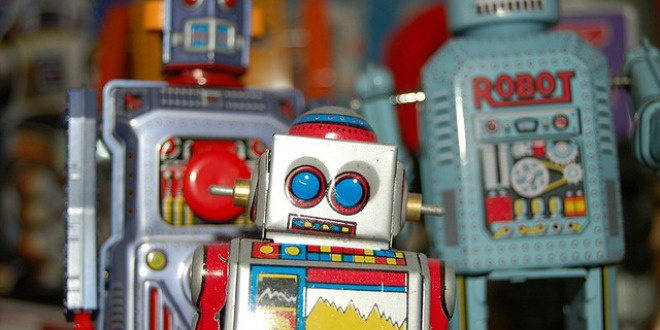How to Manufacture Software that mimics 3D Printers, Robotics, AI
Closing Date: 31 December 14
Started on: 21 August 14
Participants: 1
As we all know that manufacturing is undergoing rapid and radical transformation with the advent of 3D printers, robotics and artificial intelligence (AI)
3D printers are a radical departure which promise close to zero wastage during the building process. There are different kinds of 3D printers right from those to be used by retail consumers to industrial scale. Also different 3D printers work with different materials depending upon which domain it is, for example, 3D printers in the biological field vis-a-vis 3D printers in the artificial jewelery/footwear field.
Robotics are being increasingly used on the assembly line to take up work which is repeatable. Robots are being built which can learn a new job and then be deployed and re-deployed as the process changes
AI is helping the Robots to learn new tasks and make intelligent decisions. AI can also result in the self-healing products that can check what is wrong and then either take the appropriate actions or advice on what needs to be corrected.
So can Software mimic the advances taking place in manufacturing?
Software as we all know generally encounters a lot of defects, is labor intensive and subjective.
Can there be software printers that mimic 3D printing - given a set of requirements generate the end deployable software package (which includes the code)? Here there will be different kinds of Blueprints (aka metamodels and models) and materials (aka languages/frameworks/OS/API) which will result in the appropriate output. This will require the building of software 3D printers that take the model and then generate the output. In future there will be people who know the domain to build models and there will be people who know how to build software 3D printers based on the appropriate languages/frameworks/OS/API. There could be other disruptive forces also which we have no knowledge of at this point.
Can there be software robots that look at the business processes and take up the repeated tasks? The cloud based software services are particularly amenable to software robots as they can automate a number of tasks.
How can AI be made best use of during development and then during the software lifecycle? AI can become playground for software that learns and evolves i.e self healing software.

Software Robots: The Long Tail of Automation | Innovation Insights | WIRED
http://www.wired.com/2014/01/software-robots-long-tail-automation/
In 2004, Chris Anderson?s now famous Wired article introduced the World to the Long Tail of niche marketing. This is a frequency distribution ? a graph, that can be used to understand a retailing strategy for selling a large number of unique items in individually small volumes. He showed how the internet, and the likes?
3D printers are a radical departure which promise close to zero wastage during the building process. There are different kinds of 3D printers right from those to be used by retail consumers to industrial scale. Also different 3D printers work with different materials depending upon which domain it is, for example, 3D printers in the biological field vis-a-vis 3D printers in the artificial jewelery/footwear field.
Robotics are being increasingly used on the assembly line to take up work which is repeatable. Robots are being built which can learn a new job and then be deployed and re-deployed as the process changes
AI is helping the Robots to learn new tasks and make intelligent decisions. AI can also result in the self-healing products that can check what is wrong and then either take the appropriate actions or advice on what needs to be corrected.
So can Software mimic the advances taking place in manufacturing?
Software as we all know generally encounters a lot of defects, is labor intensive and subjective.
Can there be software printers that mimic 3D printing - given a set of requirements generate the end deployable software package (which includes the code)? Here there will be different kinds of Blueprints (aka metamodels and models) and materials (aka languages/frameworks/OS/API) which will result in the appropriate output. This will require the building of software 3D printers that take the model and then generate the output. In future there will be people who know the domain to build models and there will be people who know how to build software 3D printers based on the appropriate languages/frameworks/OS/API. There could be other disruptive forces also which we have no knowledge of at this point.
Can there be software robots that look at the business processes and take up the repeated tasks? The cloud based software services are particularly amenable to software robots as they can automate a number of tasks.
How can AI be made best use of during development and then during the software lifecycle? AI can become playground for software that learns and evolves i.e self healing software.

Software Robots: The Long Tail of Automation | Innovation Insights | WIRED
http://www.wired.com/2014/01/software-robots-long-tail-automation/
In 2004, Chris Anderson?s now famous Wired article introduced the World to the Long Tail of niche marketing. This is a frequency distribution ? a graph, that can be used to understand a retailing strategy for selling a large number of unique items in individually small volumes. He showed how the internet, and the likes?
This challenge is listed under
Development & Implementations
Community
Related Posts:






1 Suggestion
This sounds like a great concept. Some companies have tried to do this, but so far it’s been tough to create code that is 100% complete. In theory the possibility of creating backend code would be more practical. Companies like Rational (now IBM) had tried to provide code generation via software design models created in Rose, but the output usually required further work until it was actually usable.
To create code that is truly complete one would need to specify a lot of detail that would make the effort investment in design and specs creation really large. For example, to create code for screens, the UX and UI would need to be detailed out to a very great level of detail. Similar challenges would arise for middleware and external interfaces.
For these reasons I think it will still be a while before 3D printing can become a reality.